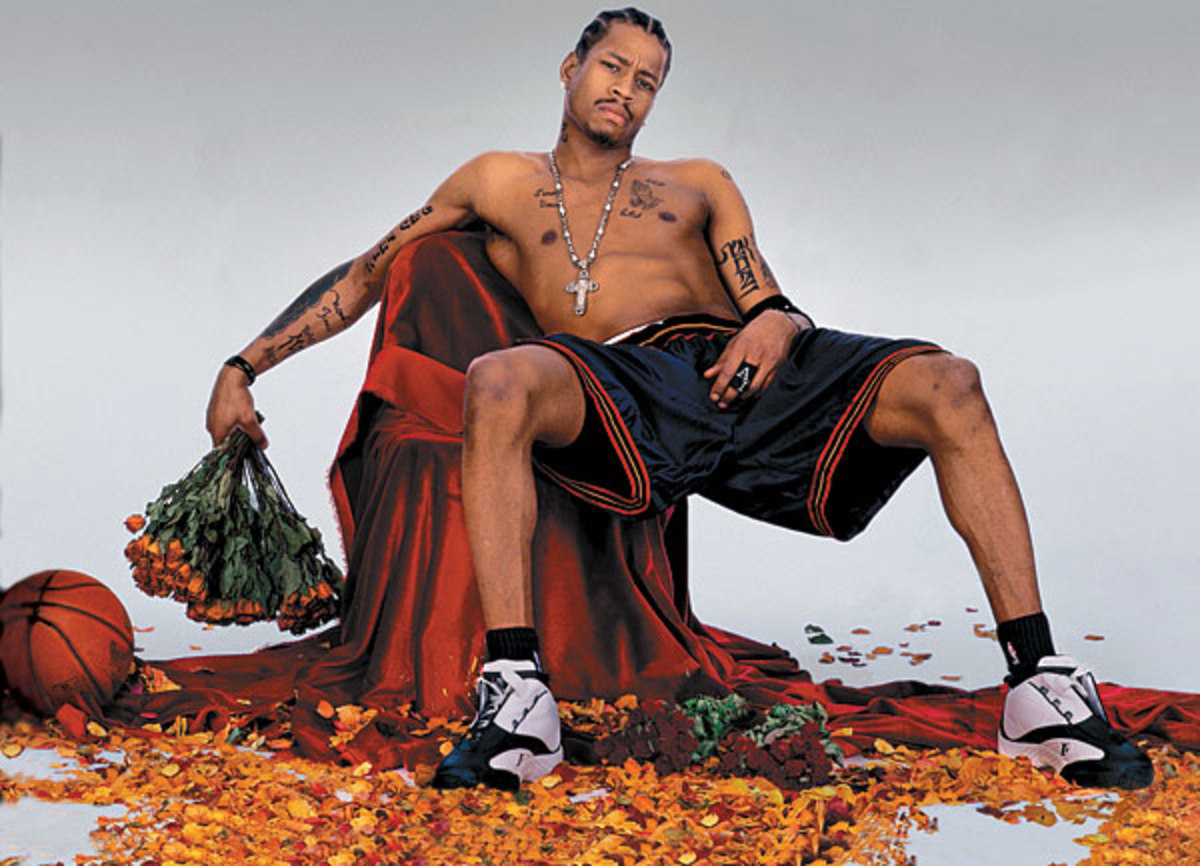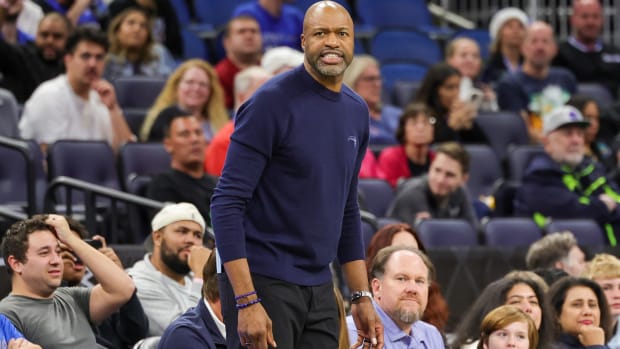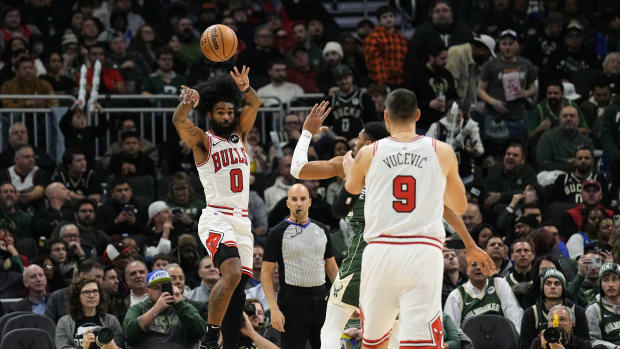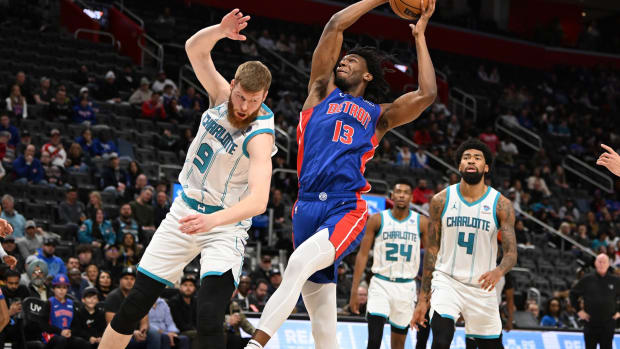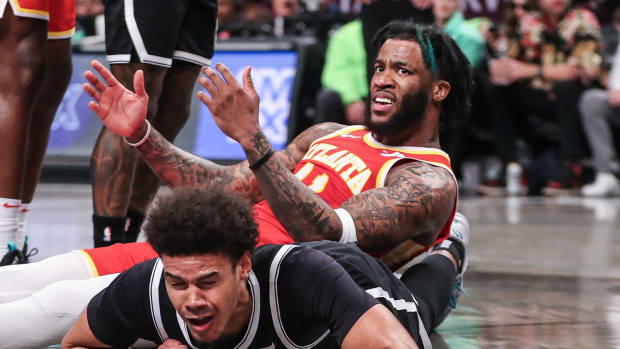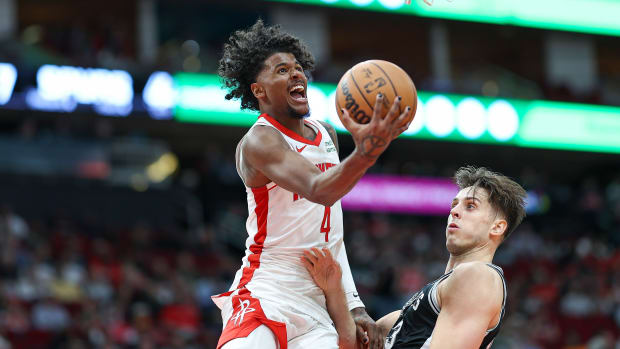Remembering Allen Iverson's career
Allen Iverson poses during a Sports Illustrated cover shoot in 2001. (Gerard Rancinan/SI)
Allen Iverson will announce his retirement in Philadelphia on Wednesday to coincide with the Sixers' season opener against the Heat. When SlamOnline.com reported in August that Iverson's official retirement was expected soon, the news was met by guffaws in some corners, mostly because he hasn't appeared in an NBA game in more than three years. That was unfortunate, because there was true genius to what Iverson did well. And, really, it shouldn't come as a surprise that it's taken years for the 38-year-old guard to process his separation from a game that he helped shape on the court and a generation of players he helped shape off it.
Statisticians will look back on Iverson's numerical product with wide eyes. Even with a famously slight frame, Iverson led the league in minutes per game seven times in a 10-year span, and he averaged an outrageous 45.1 minutes during his eight postseason runs. The four-time scoring champion will go down as a man who gobbled up possessions unlike any player before or since. Only one player in Basketball-Reference's database has posted a usage rate higher than 35 percent while shooting less than 40 percent (in at least 200 minutes in a season). That player is Iverson, and he managed the feat twice. To put that into perspective, notorious chucker Monta Ellis has never had a season in which he had either a usage rate higher than 30 percent or a field-goal percentage less than 41.
Still, Iverson carried the Sixers to the playoffs year after year; averaged more than 30 points three times; earned the 2001 MVP award; made seven All-NBA teams; and came within three wins of winning a title, in 2001.
Some might argue that his pure brashness eclipsed those basketball heights, an unbending personality that reflected a hip-hop culture he proudly helped carry to mainstream America. The baggy clothes, sneakers, throwback jerseys, tattoos, headbands, jewelry, cornrows and even the shooting sleeve were all new, at least for a player with his talent and profile. They were also incredibly polarizing: An entire generation of guards cite him as the singular role model, while commissioner David Stern instituted a dress code to squash a developing image of NBA players that, then and now, is largely associated with Iverson. This stuff might come first in the "legacy" discussion.
Paying tribute to Iverson's career requires photographs and video: He was as photogenic off the court as he was smooth on it. With that in mind, here are 10 scenes by which to remember Iverson's time as a basketball icon, which began nearly 20 years ago.
1. Allen Iverson as flash point
Allen Iverson is pictured in 1993, the same year he was sent to prison for three felony convictions. (Bill Frakes/SI)
It was clear early that Iverson was destined for a career of headlines. More than three years before Iverson made his NBA debut, he was the subject of an unforgettable Oct. 25, 1993, Sports Illustrated article that chronicled a racially charged bowling alley fight. An 18-year-old Iverson was convicted of maiming by mob and sentenced to five years in prison. The NAACP and the SCLC came to his defense, and the justice system's treatment of Iverson sparked civil rights protests in Virginia. Here's a passage from Ned Zeman's story:
Last Saturday 150 protesters marched through Hampton, chanting, "Free the Hampton Four" and "No justice, no peace," and singing Which Side Are You On? All the police ringing the demonstration were white; only one protester was white.
Around Hampton and nearby Newport News these days, blacks are wearing FREE IVERSON T-shirts; graffiti on buildings reads JUSTICE FOR BUBBACHUCK. Members of the Bethel High football team have refused to talk to reporters, and some black leaders have contemplated an economic boycott against local merchants and the media.
2. Allen Iverson as phenom
Allen Iverson averaged 23 points in two seasons with Georgetown. (Manny Millan/SI)
Virginia Gov. Douglas Wilder eventually granted Iverson a conditional clemency after four months in prison. The electrifying guard went on to make an immediate impression at Georgetown, where he led the Hoyas to the NCAA tournament twice and averaged 25 points as a sophomore on his way to All-America honors. His national reputation as an unstoppable force off the dribble and instinctual scorer blossomed. So, too, did his role as a fashion trend-setter, as the combination of Georgetown's gray jerseys and the iconic Jordan XIs holds up to this day, and will for decades.
As Jack McCallum noted in a Dec. 5, 1994, Sports Illustrated article, the force of Iverson's brash personality was present at the beginning of his freshman season.
All speculation about whether John Thompson would turn the reins of his usually conservative sleigh over to quicksilver freshman point guard Allen Iverson ended when Iverson pushed the ball upcourt after both makes and misses, took three-point jumpers whenever and from wherever he damn well pleased, scolded his teammates when they screwed up, and in general conducted himself like the second coming of Isiah Thomas. Which he is. Never mind the ugly numbers that Iverson put up on Sunday—5-for-18 shooting (19 points) and more turnovers (eight) than assists (two). He is one of the most exciting guards to come along in years, and Thompson should be praised, not buried, for giving Iverson a lot of rope. If his young supporting cast (Michael Jordan's Chicago Bull teammates never liked that phrase, either, but there it is) can keep up with Iverson, the Hoyas will be a factor come tournament time.
And how about this incredible one-liner from a January 1996 SLAM Magazine story by Scoop Jackson.
How nice IS Ive? Right about now, Arkansas coach Nolan Richardson says, “I’ve been to three calf shows, nine horse ropings and seen Elvis once. But I ain’t never seen anything like it in my life.”
3. Allen Iverson as Jordan-crosser
http://youtu.be/bLhI9cgsO4c
Few highlights stand the test of time as well as this one: Iverson, closing in on the 1997 Rookie of the Year award after being the first pick in the 1996 draft, unleashed a vicious double crossover on Michael Jordan, who was on his way to his fifth title. The play endures because it combines Iverson's signature dribble move with his trademark fearlessness. Here's Mark Perner of the Philadelphia Daily News setting the stage.
On March 12, 1997, as his rookie season was reaching the finish line, Iverson and the Sixers were facing the NBA champion Chicago Bulls and Michael Jordan. Iverson lit up the Bulls, tying a then-career high with 37 points, although the Sixers, despite a solid showing, bowed to the Bulls, 108-104. But what defined this game was one move, Iverson's signature, the crossover.
...
He rocked Jordan once with a small crossover and then dropped the big one, moving to his right and swishing a 20-foot jumper just ahead of the flailing Jordan. The crowd at the CoreStates Center, anticipating what was about to occur, rose and erupted in joy. Our guy went one-on-one with the greatest player ever and our guy won, they were thinking. At that moment, Philly fell in love with Allen Iverson. He was ours. He was our David to the NBA's Goliath. We had a star, too.
Here's how Iverson recalls it: "I used to always tell my friends that when I get on that stage, I'm going to try my move on the best. I'll never forget the play. I'll never forget coming off the screen and him switching and [Bulls coach] Phil Jackson hollering his name, telling him to switch out on me. I gave him the first little one, and I see that he's biting on it. And I hit him with the second one and I made the shot. But the craziest thing about it is I hit him with my best move and he still almost blocked it. That lets you know how great of a defensive player that he was."
Video via YouTube user loklin88.
4. Allen Iverson as pitchman
Allen Iverson laces up his Reebok Answer sneakers during an appearance at the Wells Fargo Center in Philadelphia last year. (Jeff Fusco/Getty Images for Reebok)
Iverson's individual brand was so hot from the start that he signed a 10-year, $50 million endorsement deal with Reebok as a rookie. In 2001, the deal was extended to a lifetime contract. His Reebok "Question" sneakers were a monster hit.
5. Allen Iverson as cover boy
Allen Iverson on the March 1999 cover of Slam Magazine. (Slam Magazine)
The 11-time All-Star graced plenty of magazine covers throughout his career (including Sports Illustrated), but none struck a chord quite like the March 1999 issue of SLAM Magazine, which featured Iverson with his hair blown out, decked out in jewelry, wearing a throwback Sixers jersey and holding an ABA basketball. The look on his face said, simply, "What?" SLAM later convened a panel to discuss the iconic cover.
Que Gaskins, Reebok: It had all the right cultural codes for what was cool, what was authentic, what was relevant. Nobody else could pull it off.
Scoop Jackson, Slam Magazine: He was holding down everything that Michael Jordan wasn’t.
...
Andre Iguodala: I was a freshman or sophomore in high school. I’d never heard of SLAM until that one—AI with his hair blown out. One kid had it, and it ended up getting to the whole basketball team by the end of the day. It was that crazy. We switched it after every class, like, “Oh, you gotta check this out.” It was real, and it brought the hip-hop edge to it, too.
6. Allen Iverson as Finals hero
http://youtu.be/grXws5m11SA
Want to boil down Iverson's game to one play? Look no further than this sequence from Game 1 of the 2001 Finals between Iverson's Sixers and the Lakers. Driving past Tyronn Lue to the right, Iverson effortlessly slammed on the brakes with a crossover before smoothly stepping into a jumper. Lue wound up stumbling to the court in front of the Lakers' bench, and Iverson seized the opportunity to declare his superiority, purposefully stepping over Lue on his way back down the court. Quickness, skill, confidence and defiance, all in six seconds. If ever there was a "poster" long two-point shot, this was it.
Iverson finished with 48 points in a 107-101 overtime victory, and he played all 52 minutes. (The Lakers came back to win the next four games and the title.)
Video via YouTube user sim12106.
7. Allen Iverson as villain
http://youtu.be/d29VsG35DQM
For Iverson's detractors, his infamous 2002 "practice" rant embodied everything that was wrong with his "My way or the highway" approach. Called out by coach Larry Brown for his practice habits, Iverson went on, and on, and on in response.
Here's a transcript of his full rant, for posterity.
"I'm supposed to be the franchise player and we're in here talking about practice. Listen, we talking about practice. Not a game, not a game, not a game, we're talking about practice. Not a game. Not the game that I go out there and die for and play every game like it's my last. Not the game. We're talking about practice, man. I mean, how silly is that? We're talking about practice.
"I know I'm supposed to be there, I know I'm supposed to lead by example. I know that. I'm not shoving it aside like it don't mean anything. I know it's important. I do. I honestly do. But we're talking about practice man. What are we talking about? Practice? We're talking about practice, man. We're talking about practice. We're talking about practice. We ain't talking about the game. We're talking about practice, man.
"When you come to the arena and you see me play, you see me play, don't you? You see me give everything I've got, right? We're talking about practice right now. We're talking about practice. It's funny to me too. It's strange to me too. But we're talking about practice, man. We're not even talking about the game, the actual game, when it matters. We're talking about practice.
"How the hell can I make my teammates better by practicing?"
What kind of leader, some wondered, would marginalize the importance of training? What kind of role model -- not to mention millionaire -- would lose his cool and express such public disdain for a part of his job? And, the worst (rhetorical) question of all: Would Michael Jordan have ever done something like this? The rant led many -- at the news conference and in the years since -- to laugh at Iverson's obvious frustration, but the exchange left a stain and fueled criticism.
8. Allen Iverson as the opposition
An injured Allen Iverson watches the Sixers from the bench in 2004. (Jamie Chojnacki/NBAE via Getty Images)
No player merged hoops and hip hop quite like Iverson. He hung out with rappers, enjoyed a luxurious lifestyle and wore everything from baggy jerseys and jeans to gear inspired by military fatigues. By 2005, Stern had had enough. As Chris Mannix reported in the Oct. 17, 2005, issue of Sports Illustrated, Stern was championing a new look for his players with an eye toward image. Who would supply the go-to quote critical of the new dress code? Iverson, of course.
Commissioner David Stern has announced his intention to implement a dress code for inactive players on the bench and players at team functions and on road trips. Dress shirts and slacks will be mandatory; T-shirts, 'do-rags and the velour sweats that are all the rage will be verboten. "It's a small thing that contributes to a sense of professionalism," said Stern.
Dress codes in the NBA are nothing new. Coaches must wear sport coats and ties or turtlenecks. (Last season, Denver's George Karl was fined $10,000 for wearing a throwback jersey during a game.) Players don't mind rules for sideline attire, but they object to being told what to wear away from the arena. (A league source says the policy could be announced next week.) Says Sixers guard Allen Iverson, "Just because you put a guy in a tuxedo doesn't make him a good guy."
Iverson wasn't done there. A few weeks later, Elizabeth Newman wrote the following in the Nov. 21, 2005, issue of Sports Illustrated.
The NBA's new dress code may have rankled some--the 76ers' Allen Iverson said the league went "way overboard" by taking away players' individuality.
As Phil Taylor noted in the July 7, 2008, issue of Sports Illustrated, the dress code was really a follow-up to a corporate-friendly pattern of decision-making that dated to at least 2001, when the NBA's official Hoop Magazine erased Iverson's tattoos.
Yet those same corporate entities want to keep that culture at arm's length, lest it get too threatening to the paying customers. Thus we have the airbrushing of Allen Iverson's tattoos in an NBA-produced magazine, and the league's dress code, which makes sure the players won't look too much like some of the musical artists the league otherwise embraces. You may call it racist and hypocritical; they call it good business.
The years following the institution of the dress code coincided with Iverson's post-30 age-related decline. He moved from Philadelphia to Denver to Detroit to Memphis and, finally, back to Philadelphia, but his numbers just kept dropping along the way. He finally played his last NBA game, for the Sixers, on Feb. 20, 2010. All sorts of ugly off-court problems were already swirling.
9. Allen Iverson as export
http://youtu.be/tjzuXYqLAWA
It would have been naive to expect an ultra-competitive player such as Iverson to go gracefully and quickly into retirement. With age catching up and red flags mounting, Iverson elected to sign a two-year contract with Turkish club Besiktas in 2010. His hope, Chris Mannix reported in the Nov. 8, 2010, issue of Sports Illustrated, was to get another NBA shot.
"My whole thing was being wanted and being accepted by a ball club," Iverson said. "That was the most important thing to me."
Why is Iverson, an 11-time All-Star and one of the best little men in league history, no longer wanted in the NBA? The answer to that might just be the Answer himself. Iverson's balking at coming off the bench with Detroit led to his banishment from the Pistons at the end of the 2008--09 season. He encountered similar problems with Memphis, which waived him after just three games in '09. "I don't think my basketball talents have anything to do with the reasons I'm not on an NBA roster right now," says Iverson. "I made a lot of mistakes. And obviously it cost me."
...
He has an opt-out clause in his contract after the first year, and a source close to Iverson says he is hoping a year as a good player—and a good soldier—will get him another shot in the NBA. "I'd be lying if I said [getting back to the NBA] wasn't an issue," says Iverson. "A lot of me not being in the NBA is my fault, but I can't cry over that. I have to move forward."
Iverson's time in Turkey was brief, due to a leg injury, and the most memorable moment might very well have been his arrival at the airport. Even years removed from his prime and halfway around the world, he attracted a horde of cameras. The scene served as a tidy reminder of his global popularity and impact.
10. Allen Iverson as conquering hero
Allen Iverson acknowledges the Philadelphia crowd during his appearance at a Sixers game in March. ( Jesse D. Garrabrant/NBAE via Getty Images)
Iverson never got another NBA shot. He has kept a fairly low profile in recent years, even as stories about his gambling, drinking, financial and marital issues surfaced. Before Wednesday, he had returned to Philadelphia on two memorable occasions: in May 2012, during the Sixers' playoff series against the Celtics; and March 2013, when he was honored with a bobblehead in his likeness. His presence drew a warm reception on both nights. He wasn't ready to talk retirement either time.
"I'm not using that word [retirement]," he said in a televised interview on ESPN in 2012. "I want to play basketball so bad."
Then, to CSNPhilly.com this year: "At some point it comes to an end regardless, however it comes, whether it is retirement or injury, at some point it comes to an end. I am happy and content with everything that has gone on in my life and I am just looking for the next phase, and if I get a chance to play again I would love the opportunity, but if not I will continue to just be happy.”






























